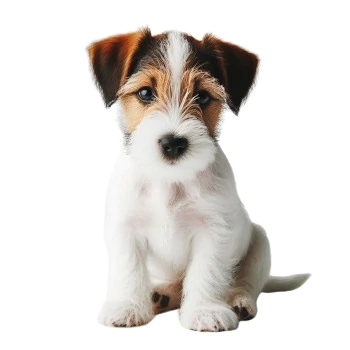
The Parson Russell Terrier is a dog breed originally from the United Kingdom, specially developed for fox hunting. Energetic, bold, and agile, it is also appreciated as a companion dog. This dog is known for its determination and courage, qualities that make it an excellent hunter.
The Parson Russell Terrier is a small terrier dog with a sturdy and well-proportioned body. It stands between 33 and 38 cm at the withers and weighs between 5.5 and 8 kg. Its head is triangular with V-shaped, drop ears. Its coat can be smooth or broken, primarily white with brown or black patches.
The Parson Russell Terrier's coat is weather-resistant and easy to maintain. It can be smooth or broken, but in any case, it is dense and fairly short. Regular brushing helps keep its coat in good condition and removes dead hair.
Parson Russell Terriers typically measure between 33 and 38 cm, and their weight ranges from 5.5 to 8 kg. Despite their small size, they are very muscular and athletic, capable of great endurance and agility in hunting activities.
The Parson Russell Terrier is a very energetic, intelligent, and fearless dog. It needs plenty of exercise and mental stimulation to avoid boredom, which could lead to destructive behaviors. While it is sociable with its family, it can be reserved with strangers and should be well socialized from a young age.
The Parson Russell Terrier is generally healthy, but like many small breeds, it can be prone to eye problems and patellar luxation. Regular veterinary check-ups and a balanced diet contribute to its good health. Due to its high energy levels, it requires plenty of physical activity to stay fit.

The Parson Russell Terrier Puppy is a small, energetic, and lively dog, originally from the United Kingdom. It was initially bred for fox hunting, which explains its lively, intelligent, and determined temperament. This compact and athletic dog possesses great agility and a cheerful nature. Although it is affectionate and loyal to its family, it can be independent and sometimes stubborn, which requires consistent training and early socialization. The Parson Russell Terrier has a strong hunting instinct, so it may be advisable to keep it under supervision when outdoors. With its boundless energy, it requires daily exercise to stay happy and balanced. Its coat, which can be smooth or slightly rough, is relatively easy to maintain.
The price of a Parson Russell Terrier Puppy depends on the breeder, lineage, and pedigree. On average, you can expect to pay around 800 to 1,500 euros.
The Parson Russell Terrier is an energetic and intelligent breed, known for its lively temperament and strong personality. Training this dog requires patience and consistency, but the results are worth it. Here are some tips for effectively training your Parson Russell Terrier.
Early Socialization: Start socialization from an early age. Expose your puppy to various environments, people, and animals to help it become a well-balanced and sociable adult. Dog parks and training classes are excellent ways to promote this socialization.
Positive Reinforcement: Use positive reinforcement methods to encourage good behaviors. Rewards such as treats, toys, or verbal praise are very effective. Avoid harsh punishments that can harm the trust relationship between you and your dog.
Regular Exercise: The Parson Russell Terrier needs plenty of exercise to channel its boundless energy. Daily walks, ball games, and search activities are essential for maintaining its physical and mental health. A tired dog is a well-behaved dog!
Learning Basic Commands: Teach basic commands like "sit", "lie down", "stay", and "come" as soon as possible. These commands are fundamental for your dog's safety and control in various situations.
Mental Stimulation: In addition to physical exercise, provide your Parson Russell Terrier with activities that stimulate its mind. Interactive toys and puzzle games can help keep it mentally active and avoid boredom.
Consistency and Patience: Be consistent in your rules and expectations. All family members should follow the same guidelines to avoid confusing the dog. Patience is also crucial, as learning can take time.